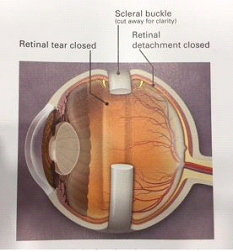

Once applied, a scleral buckle wraps around the eye to help reattach the retina and keep it attached. When the retinal detachment is more extensive, a scleral buckle may be needed to support the retina from outside the eyeball. Another in-office option is pneumatic retinopexy, the injection of a gas bubble to provide light pressure against the retina. If a patient is not having symptoms and the detachment is small, the doctor may treat with a laser to help reattach the retina. Some procedures can be done in the office, while other treatments, such as scleral buckling or vitrectomy, require an operating room. The treatment will depend on the severity of the retinal detachment and the patient’s symptoms. If a detachment is detected, they will recommend the appropriate procedure to reattach the retina. If someone is experiencing symptoms that indicate a possible retinal detachment, an eye doctor will perform a comprehensive eye exam. The goal of repairing a detached retina is to recover as much vision as possible. When the retina detaches, it can lead to profound vision loss. Scleral buckling is a treatment eye surgeons sometimes use to repair a detached retina. However, it is still considered an important treatment option for some cases of retinal detachment. As new procedures have emerged, it is not as common as it used to be. Ophthalmologists have successfully performed this eye surgery for over 50 years.

Cryopexy (freezing) may also be performed during scleral buckle surgery to help seal retinal holes or tears and reattach the retina. This includes vitrectomy, which removes and replaces the gel-like substance inside the eye to decrease traction on the retina.

Scleral buckle surgery may be performed in combination with other procedures to repair a retinal detachment. Some discomfort may be present the first few days after the surgery, but pain medication will be prescribed to help with discomfort. It is performed in an operating room and can require several weeks to fully recover. The retina successfully reattaches in about 90% of patients who have scleral buckle surgery. It wraps around the eyeball like a belt, supporting the retina. A scleral buckle is a surgery that places a permanent silicone band around the eye to help return the retina - a thin layer of tissue located in the back of the eye - into position after a retinal detachment.


 0 kommentar(er)
0 kommentar(er)
